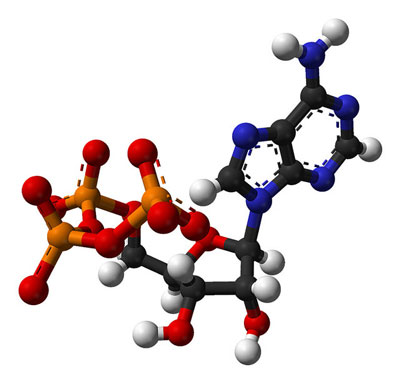| Aug 30, 2016 |
Research outlines cellular communication processes that make life possible
|
|
(Nanowerk News) Researchers have discovered a mechanism of intercellular communication that helps explain how biological systems and actions – ranging from a beating heart to the ability to hit a home run – function properly most of the time, and in some scenarios quite remarkably.
|
|
The findings are an important basic advance in how cell sensory systems function. They shed light on the poorly-understood interaction between cells - and they also suggest that some of the damage done by cancer cells can be seen as a “failure to communicate.”
|
|
The work was reported today in Proceedings of the National Academy of Sciences by physicists from Oregon State University and Purdue University, done with support from the National Science Foundation and the Simons Foundation.
|
 |
| ATP signaling molecule.
|
|
Scientists have long known that cells have various types of sensory abilities that are key to their function, such as sensing light, heat, nerve signals, damage, chemicals or other inputs.
|
|
In this process, a chemical stimulus called ATP functions as a signaling molecule, which, in turn, causes calcium levels in a cell to rise and decline, and tells a cell it’s time to do its job – whether that be sending a nerve impulse, seeing a bird in flight or repairing a wound. These sensing processes are fundamental to the function of life.
|
|
“We’ve understood for some time the basics of cellular sensory function and how it helps a cell respond to its environment,” said Bo Sun, an assistant professor of physics in the College of Science at Oregon State University, and a corresponding author on this study.
|
|
“The thing is, individual cells don’t always get the message right, their sensory process can be noisy, confusing, and they make mistakes,” Sun said. “But there’s strength in numbers, and the collective sensory ability of many cells working together usually comes up with the right answer. This collective communication is essential to life.”
|
|
In this study, researchers helped explain just how that works for animal cells.
|
|
When cells meet, a small channel usually forms between them that’s called a gap junction. On an individual level, a cell in response to ATP begins to oscillate, part of its call to action. But with gap junction-mediated communications, despite significant variability in sensing from one cell to another, the sensitivity to ATP is increased. Oscillation is picked up and becomes more uniform.
|
|
This interactive chatter continues, and a preponderance of cells receiving one sensation persuade a lesser number of cells reporting a different sensation that they must be wrong. By working in communication and collaboration, most of the cells eventually decide what the correct sensory input is, and the signal that gets passed along is pretty accurate.
|
|
With this accuracy of communication, cells in a heart chamber collectively decide to contract at the appropriate time, and blood gets pumped, dozens of times a minute, for a lifetime. Neuron cells send accurate signals. Photoreceptor cells see clearly.
|
|
This research was done with fibroblast cells, which are used in wound healing, but the results should apply to many cellular sensing mechanisms, researchers said.
|
|
Cancer cells, by contrast, are poor communicators. This study showed that they resist this process of collective communication, and when enough of them are present, the communicative process begins to lessen and break down. This may be at least one of the ways in which cancer does its biologic damage.
|
|
“These processes of collective sensory communication are usually accurate, but sometimes work better than others. Mistakes are made,” Sun said. “Even so, this process makes life possible. And when everything goes just right, the results can be remarkable.”
|
|
Consider a baseball player trying to get a hit, which Ted Williams once called “the hardest single thing to do in sport.” A major league pitcher hurls a 93 mile-per-hour fastball, low but possibly a strike.
|
|
The photoreceptor cells in the batter’s eyes see the pitch coming. Some cells see it as a curve in the dirt, and some mistake it for a changeup, a slower pitch. But the majority of the cells come to the correct conclusion, it’s a fastball at the knees, and they spread the word. After extensive communication between all these cells, a conclusion is reached and the correct message is sent to neurons in the brain.
|
|
The brain cells, in turn, send a strong signal through nerves to muscles all over the batter’s body, the shoulders, legs, and especially arms. The signals arrive and once again a collaborative process takes place, deciding what the message is and how to react. Calcium ions in muscle cells are triggered and a brutally fast-but-accurate response is triggered, swinging the bat. This entire process, from the ball leaving the pitcher’s hand to contact with the bat, takes less than half a second.
|
|
On a perfect day – the cellular debate over what pitch was coming was sufficiently short-lived, the timing exact, the muscle contractions just right – the ball explodes off the bat and sails over the center field fence.
|
|
On a more realistic day – since the best hitters in the world only succeed 3 times out of 10 – the ball bounces weakly to the second baseman for an easy out. This in turn triggers the collective groans of 30,000 disappointed fans. But the heart has cellular communication that continues to guarantee its normal beating, and the player lives to bat another day.
|

